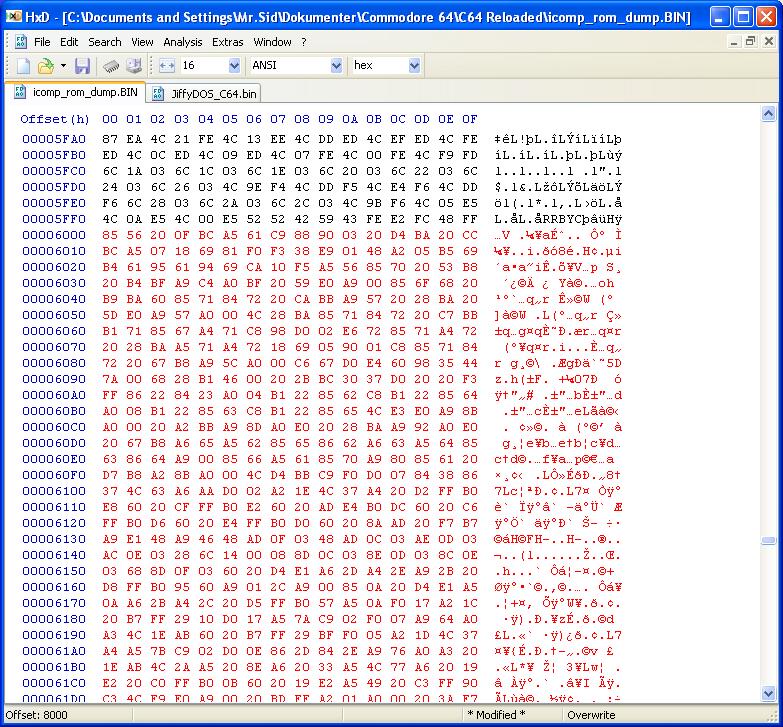
Connect the 'EEPROM Reader' to PC with USB cable - open the software 'EEPROMEditTool.exe' and press to connect button - press generate button to create parameters and/or modify like you wish - connect the cartridge with 'EEPROM Reader' - press write button to write the parameters to the cartridge chip. Use the EEPROM Resetter/Reader as standalone. Online Hex Editor. Offset size type name value # start end size type data; 1: 0: 4: 5. HexEdit has always easily edited files of any size without any extra effort on the part of the user. Before HexEdit most hex editors could not edit files bigger than they could load into memory. Since then many have copied how HexEdit works. HexEdit was the first binary editor to allow editing of files more than 4 GBytes (2^32 bytes) in size.
This project is a simple LED matrix clock. It can use either MAX7219 as LED drivers (one IC per matrix) either HT1632 LED driver. It’s possible to use 3 or 4 matrixes, but recent code is more suitable for second option.
- RTC DS1307 support (DS3231 also works)
- One alarm which can be enabled for any day of week
- Active beeper is used for alarm and signals
- Temperature measurement with DS18B20 sensors
- Pressure/temperature measurement with BMP180 sensor
- Humidity/temperature measurement with DHT22 sensor
- Scrolling date and sensors data strings
- Reducing brigtness in darkness
- MAX7219 (one per LED matrix). Pinout and schematic are here
- HT1632 (one for 4 matrixes). Pinout for JY-MCU 3208CLOCK PRO module
While project uses various parameters from EEPROM memory special desktop application to edit eeprom matrixclock_xx.bin was designed. It allows to load, modify and save eeprom binary file in easy way.
Matrixclock editor is written on Qt5 and it’s sources are availiable on Github.
- Article about the project (in Russian)
- Forum thread (in Russian)
This guide shows how to generate a .bin (binary) file from your sketch on Arduino IDE.
Generate a .bin file in Arduino IDE
As an example, we’ll generate a .bin file from the Blink example. Follow the next steps to generate a .bin file from your sketch in Arduino IDE.
Eeprom Bin File Editor Software

1) First, go to Tools > Board and select the right board (for example, ESP32 DEVKIT DOIT Board).
2) Save your sketch.
Eeprom Bin File Editor Freeware
3) To generate a .bin file from your sketch, go to Sketch > Export compiled Binary
Connect the 'EEPROM Reader' to PC with USB cable - open the software 'EEPROMEditTool.exe' and press to connect button - press generate button to create parameters and/or modify like you wish - connect the cartridge with 'EEPROM Reader' - press write button to write the parameters to the cartridge chip. Use the EEPROM Resetter/Reader as standalone. Online Hex Editor. Offset size type name value # start end size type data; 1: 0: 4: 5. HexEdit has always easily edited files of any size without any extra effort on the part of the user. Before HexEdit most hex editors could not edit files bigger than they could load into memory. Since then many have copied how HexEdit works. HexEdit was the first binary editor to allow editing of files more than 4 GBytes (2^32 bytes) in size.
This project is a simple LED matrix clock. It can use either MAX7219 as LED drivers (one IC per matrix) either HT1632 LED driver. It’s possible to use 3 or 4 matrixes, but recent code is more suitable for second option.
- RTC DS1307 support (DS3231 also works)
- One alarm which can be enabled for any day of week
- Active beeper is used for alarm and signals
- Temperature measurement with DS18B20 sensors
- Pressure/temperature measurement with BMP180 sensor
- Humidity/temperature measurement with DHT22 sensor
- Scrolling date and sensors data strings
- Reducing brigtness in darkness
- MAX7219 (one per LED matrix). Pinout and schematic are here
- HT1632 (one for 4 matrixes). Pinout for JY-MCU 3208CLOCK PRO module
While project uses various parameters from EEPROM memory special desktop application to edit eeprom matrixclock_xx.bin was designed. It allows to load, modify and save eeprom binary file in easy way.
Matrixclock editor is written on Qt5 and it’s sources are availiable on Github.
- Article about the project (in Russian)
- Forum thread (in Russian)
This guide shows how to generate a .bin (binary) file from your sketch on Arduino IDE.
Generate a .bin file in Arduino IDE
As an example, we’ll generate a .bin file from the Blink example. Follow the next steps to generate a .bin file from your sketch in Arduino IDE.
Eeprom Bin File Editor Software
1) First, go to Tools > Board and select the right board (for example, ESP32 DEVKIT DOIT Board).
2) Save your sketch.
Eeprom Bin File Editor Freeware
3) To generate a .bin file from your sketch, go to Sketch > Export compiled Binary
4) A new file on the folder sketch should be created. Go to Sketch > Show Sketch Folder.
5) You should have two files in your Sketch folder: the .ino and the .bin file.
Eeprom Bin File Editor Tool
Related content: ESP32 Over-the-air (OTA) Programming – Web Updater Arduino IDE
Green screen app for mac. We hope you’ve found this guide useful.
Eeprom Bin File Editor Download
Thanks for reading!
